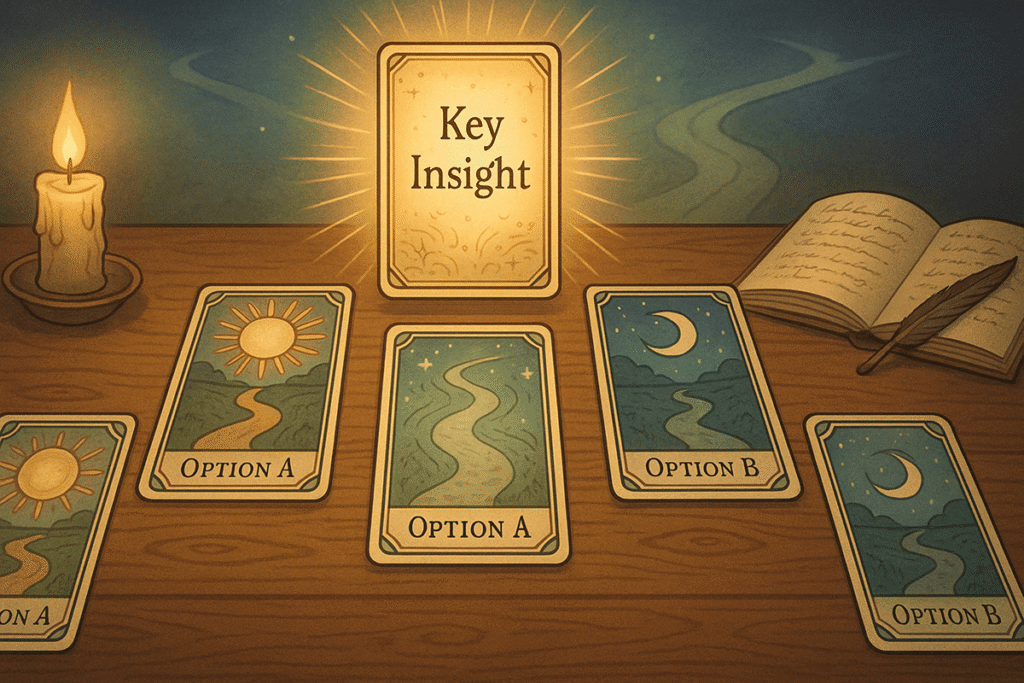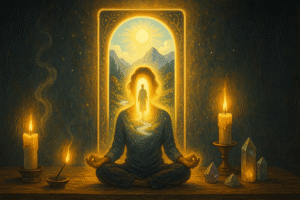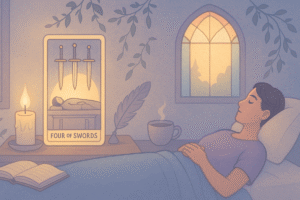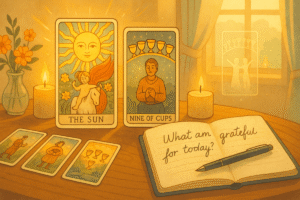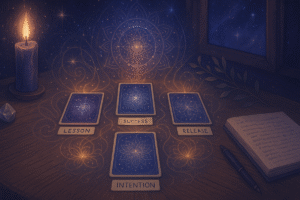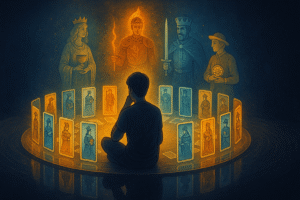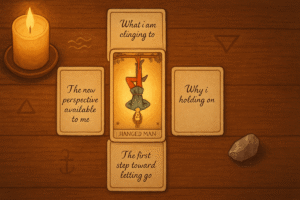Table of Contents
We’ve all been there. Standing at a crossroads, weighing two different paths, feeling that familiar knot in our stomach that comes with big decisions. Maybe it’s choosing between job offers, wondering whether to move to a new city, or deciding if it’s time to end a relationship. Sometimes our logical mind knows what makes sense, but something deeper feels unsettled.
This is where tarot can become a valuable companion in your decision-making process. Not as a fortune teller or magical predictor of the future, but as a mirror that reflects back the wisdom you already carry within yourself. The cards don’t make decisions for you. Rather, they create space for your subconscious thoughts and feelings to surface, helping you examine your choices from angles you might not have considered.
Understanding Tarot as a Reflection Tool
I think one of the most misunderstood aspects of tarot is this idea that the cards somehow “know” what will happen or can tell you what to do. In my experience working with tarot, the real magic happens when we approach the cards as conversation starters with our inner selves. They’re prompts that help us access our own intuition and examine our authentic feelings about the situations we’re navigating.
When you’re facing a difficult choice, your conscious mind might be spinning in circles, creating pro and con lists, seeking advice from friends and family. But sometimes what we really need is to get quiet and listen to what we already know deep down. The imagery and symbolism in tarot cards can bypass our overthinking minds and speak directly to that deeper knowing.
This approach treats tarot as a form of guided self-reflection, similar to journaling or meditation. You’re not looking for the cards to give you definitive answers. Instead, you’re using them as a framework to explore your own thoughts, feelings, and concerns about the paths ahead of you.
The Five Card Decision Making Spread
For decision-making work, I’ve found that a five-card spread offers enough depth to truly explore a situation without becoming overwhelming. This layout helps you examine both options you’re considering while also uncovering hidden factors that might be influencing your choice.
Here’s how to set up the spread:
Card 1: Your Current Situation Place this card in the center of your reading space. This represents where you are right now, the context from which you’re making this decision.
Card 2: Option A Place this card to the left of the center card. This reflects the energy, potential outcomes, or your subconscious feelings about your first choice.
Card 3: Option B Place this card to the right of the center card. This mirrors your second option in the same way.
Card 4: Hidden Influences Place this card above the center card. This reveals factors you might not be consciously considering that could be affecting your decision-making process.
Card 5: Your Inner Compass Place this card below the center card. This reflects your deepest wisdom about this situation and what direction feels most aligned with your authentic self.
Preparing for Your Reading
Before you begin, take a moment to center yourself. Perhaps light a candle, make a cup of tea, or simply sit quietly for a few minutes. This isn’t about creating mystical atmosphere. It’s about slowing down and creating space for reflection, which our busy lives often don’t allow.
Shuffle your cards while thinking about your decision. You might even speak your question out loud: “I’m trying to choose between X and Y. What do I need to understand about these options?” There’s something powerful about giving voice to our dilemmas. It makes them more real, more workable.
As you shuffle, notice what thoughts or feelings arise. Sometimes anxiety surfaces, or excitement, or that feeling of already knowing what you want to do but being afraid to admit it. Don’t try to push these feelings away. They’re part of the information you’re gathering.
Interpreting Your Cards Thoughtfully
When you’ve laid out all five cards, resist the urge to immediately start analyzing. Just look at the overall picture first. What’s your initial emotional response to the layout? Do the images feel harmonious or conflicted? Does one side of the spread feel heavier or more vibrant than the other?
For the center card representing your current situation, consider what aspects of your life this card might be highlighting. If you drew The Hermit, for instance, you might reflect on whether you’ve been in a period of introspection or isolation. If it’s the Three of Pentacles, perhaps collaboration and community support are important themes in your current circumstances.
The cards representing your two options aren’t telling you which choice is “right” or “wrong.” Instead, they’re inviting you to explore your subconscious associations with each path. A card like the Two of Swords might suggest that one option feels like it requires you to make peace with conflicting priorities. The Ace of Wands might reflect new creative energy or passion that one choice could ignite.
Pay attention to which option’s card resonates more strongly with you emotionally. Sometimes we think we want one thing, but when we see it reflected back to us, we realize our heart is pulling us in a different direction.
Working with Hidden Influences
The fourth card often reveals the most surprising insights. This position can illuminate fears, desires, expectations from others, or practical considerations that we haven’t been fully acknowledging.
Maybe you’ve been telling yourself that a decision is purely practical, but this card reveals deeper emotional needs at play. Or perhaps you thought you were choosing based on your heart, but there are security concerns you haven’t wanted to face. Sometimes this card points to the influence of family expectations, past experiences, or future worries that are coloring your present choice.
I find it helpful to journal about this card specifically. What does it bring up for you? What have you not been willing to admit to yourself about this decision? Sometimes the things we try not to think about are exactly what we need to examine more closely.
Listening to Your Inner Compass
The bottom card in this spread is perhaps the most important. This isn’t the “answer” to your dilemma, but rather a reflection of your deepest wisdom about the situation. Sometimes this card challenges us. If you’ve been leaning toward the practical choice but this card suggests following your creativity, it might be inviting you to reconsider your priorities.
Other times, this card confirms what you already suspected you knew. That sense of validation can be incredibly valuable when making difficult choices. It’s not that the card is telling you what to do, but rather reflecting back the wisdom you’ve been carrying all along.
Consider how this card relates to your core values and long-term vision for your life. Does one of your options align more closely with this energy? What would it look like to make a decision from this deeper place of knowing?
The Three Card Alternative
If five cards feel like too much, or if you’re dealing with a simpler decision, you can work with just three cards. Use the same basic structure: one card for Option A, one for Option B, and one representing what you most need to consider or understand about this choice.
This simplified version can be especially helpful for everyday decisions or when you’re just starting to work with tarot. The three-card format is less intimidating and forces you to focus on the essential elements of your situation.
Making Your Decision
After you’ve spent time reflecting on your cards and perhaps writing about what they brought up for you, sit quietly and notice how you feel. Has anything shifted in your perspective? Do you have new questions to explore? Sometimes a tarot reading doesn’t immediately clarify which choice to make, but it does help you understand what factors are most important to consider.
Remember, the cards are not making this decision for you. You are. They’ve simply provided a framework for accessing your own wisdom and examining your authentic feelings about the paths ahead. Trust that you have everything you need within yourself to make the right choice for your life.
Sometimes after a reading like this, one option will feel clearly more aligned. Other times, you might realize you need more information, or that there’s a third option you hadn’t considered. Both outcomes are valuable. The goal isn’t to get a definitive answer from the cards, but to gain clarity about your own thoughts, feelings, and values regarding this choice.
Moving Forward with Intention
Whatever decision you ultimately make, you can move forward knowing that you’ve taken time to really examine your options thoughtfully. You’ve listened not just to the practical considerations, but to your deeper wisdom as well. This kind of reflective decision-making tends to lead to choices we can stand behind, even when they don’t turn out exactly as we hoped.
The beautiful thing about approaching decisions this way is that it honors both your rational mind and your intuitive knowing. It acknowledges that good decisions often require us to consider information that can’t be captured in simple pros and cons lists. Our feelings, our values, our dreams for the future, and yes, even our fears all provide important guidance.
Whether your tarot reading confirms the direction you were already leaning or surprises you with new perspectives, you now have a richer understanding of the choice you’re making. And perhaps that’s the real gift of this practice. Not knowing the future, but knowing ourselves more deeply as we create that future one decision at a time.
Frequently Asked Questions
What if the cards for both options seem equally positive or equally challenging?
This often happens when both choices are genuinely viable paths, or when the real question isn’t about which option is “better” but about what you truly value. When cards feel balanced, look at the hidden influences and inner compass positions for guidance, and pay attention to which option resonates more with your core values even if both outcomes seem similar.
Can I pull clarifying cards if I don’t understand what a card is telling me?
Absolutely, and this can be really helpful when a card’s meaning feels unclear in context. Just shuffle your remaining deck while focusing on the specific card or position you need more clarity about, then draw one additional card. Think of clarifying cards as asking follow up questions in a conversation with yourself.
Should I do this reading multiple times if I’m still unsure after the first one?
Generally, it’s better to sit with your first reading for a few days rather than immediately reading again on the same question. Your understanding of the cards often deepens over time as you reflect on them. If you do decide to read again after some time has passed, approach it as exploring new aspects of the decision rather than looking for a different answer.
What if I draw the same cards for both options?
This is surprisingly common and actually quite meaningful. Identical or very similar cards for both options often suggest that the outcomes may be more alike than different, or that the decision itself isn’t the most important factor. Sometimes this indicates that your attitude or approach matters more than which specific path you choose.

